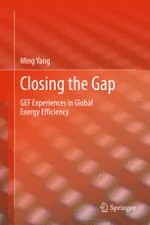2013 | OriginalPaper | Chapter
7. Cost-Effectiveness of Energy Efficiency Investments
Activate our intelligent search to find suitable subject content or patents.
Select sections of text to find matching patents with Artificial Intelligence. powered by
Select sections of text to find additional relevant content using AI-assisted search. powered by
Abstract
 This chapter shows how the Global Environment Facility (GEF) has utilized public funds to close the global energy efficiency gap. It provides an analysis of the cost-effectiveness of the 49 completed energy efficiency projects and compares levels of mobilized co-finance by sub-area; the length of project preparation period by sub-area, implementing Agency, and country; and the cost of GHG mitigation. A list of these 49 projects is presented in the appendix. On average, one dollar of GEF investment in energy efficiency was matched with approximately 8.2 dollars of co-finance. Heating projects generated the highest co-finance ratio. Appliances and equipment projects achieved the lowest unit abatement costs: US$0.24 per metric ton of direct greenhouse gas (GHG) emissions reductions (In this book, GHG emissions reductions refers to direct emissions reductions if they are not specifically indicated as “indirect emissions reductions”) with GEF resources, and US$0.96 per metric ton with total funds (GEF resources and co-finance). The unit abatement cost for all 49 projects, which collectively mitigated approximately 600 million metric tons of carbon dioxide (CO2) equivalent (MMTCO2e) emissions, was approximately US$0.53 per metric ton with GEF funds and US$4.87 per metric ton with total funds. Six of the 10 sub-areas had below-average preparation period lengths. The average time used for preparation was approximately 4 months less than that estimated in the project preparation guidelines, signifying efficient project preparation. Both tangible and intangible technological investments can significantly mitigate GHG emissions if the investments are appropriate. Tangible investments can lead to visible or measurable GHG emissions reductions, and intangible investments are essential to completing market transformations for energy efficient technologies. Tangible investments in the 49 analyzed projects realized not only hardware acquisition, but also the transfer of 49 technology patents, the training of more than 1.3 million people, and the creation of 12 energy efficiency standards and codes, 21 financial instruments, and 29 market-based mechanisms for energy efficiency development.
This chapter shows how the Global Environment Facility (GEF) has utilized public funds to close the global energy efficiency gap. It provides an analysis of the cost-effectiveness of the 49 completed energy efficiency projects and compares levels of mobilized co-finance by sub-area; the length of project preparation period by sub-area, implementing Agency, and country; and the cost of GHG mitigation. A list of these 49 projects is presented in the appendix. On average, one dollar of GEF investment in energy efficiency was matched with approximately 8.2 dollars of co-finance. Heating projects generated the highest co-finance ratio. Appliances and equipment projects achieved the lowest unit abatement costs: US$0.24 per metric ton of direct greenhouse gas (GHG) emissions reductions (In this book, GHG emissions reductions refers to direct emissions reductions if they are not specifically indicated as “indirect emissions reductions”) with GEF resources, and US$0.96 per metric ton with total funds (GEF resources and co-finance). The unit abatement cost for all 49 projects, which collectively mitigated approximately 600 million metric tons of carbon dioxide (CO2) equivalent (MMTCO2e) emissions, was approximately US$0.53 per metric ton with GEF funds and US$4.87 per metric ton with total funds. Six of the 10 sub-areas had below-average preparation period lengths. The average time used for preparation was approximately 4 months less than that estimated in the project preparation guidelines, signifying efficient project preparation. Both tangible and intangible technological investments can significantly mitigate GHG emissions if the investments are appropriate. Tangible investments can lead to visible or measurable GHG emissions reductions, and intangible investments are essential to completing market transformations for energy efficient technologies. Tangible investments in the 49 analyzed projects realized not only hardware acquisition, but also the transfer of 49 technology patents, the training of more than 1.3 million people, and the creation of 12 energy efficiency standards and codes, 21 financial instruments, and 29 market-based mechanisms for energy efficiency development.